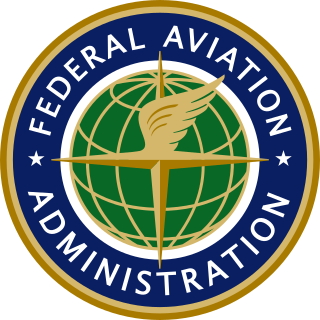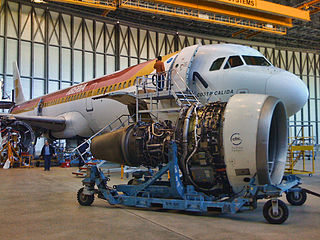
The Federal Aviation Administration (FAA) is a U.S. federal government agency within the U.S. Department of Transportation which regulates civil aviation in the United States and surrounding international waters. Its powers include air traffic control, certification of personnel and aircraft, setting standards for airports, and protection of U.S. assets during the launch or re-entry of commercial space vehicles. Powers over neighboring international waters were delegated to the FAA by authority of the International Civil Aviation Organization.
The Federal Aviation Regulations (FARs) are rules prescribed by the Federal Aviation Administration (FAA) governing all aviation activities in the United States. The FARs comprise Title 14 of the Code of Federal Regulations. A wide variety of activities are regulated, such as aircraft design and maintenance, typical airline flights, pilot training activities, hot-air ballooning, lighter-than-air aircraft, human-made structure heights, obstruction lighting and marking, model rocket launches, commercial space operations, model aircraft operations, Unmanned Aircraft Systems (UAS) and kite flying. The rules are designed to promote safe aviation, protecting pilots, flight attendants, passengers and the general public from unnecessary risk.

A private pilot licence (PPL) or private pilot certificate is a type of pilot licence that allows the holder to act as pilot in command of an aircraft privately. The basic licence requirements are determined by the International Civil Aviation Organization (ICAO), but implementation varies from country to country. According to ICAO, an applicant must be at least 17 years old, demonstrate appropriate knowledge and skill, and hold at least a Class 3 medical certificate. Different PPLs are available for different categories of aircraft, such as aeroplane, helicopter, airship, etc., and are not interchangeable, although experience from a PPL in one category may be credited towards the issue of another.
The airline transport pilot license (ATPL), or in the United States of America, an airline transport pilot (ATP) certificate, is the highest level of aircraft pilot certificate.
Pilot licensing or certification refers to permits for operating aircraft. Flight crew licences are issued by the civil aviation authority of each country, which must establish that the holder has met minimum knowledge and experience before issuing licences. The licence, along with the required class or type rating, allows a pilot to fly aircraft registered in the licence issuing state.

Pilot certification in the United States is typically required for an individual to act as a pilot-in-command of an aircraft. It is regulated by the Federal Aviation Administration (FAA), a branch of the U.S. Department of Transportation (USDOT). A pilot may be certified under 14 Code of Federal Regulations (CFR) Part 61 or 14 CFR Part 141. Pilots may also be certified under 14 CFR Part 107 for commercial drone operations.

A type certificate signifies the airworthiness of a particular category of aircraft, according to its manufacturing design. Certification confirms that the aircraft of a new type intended for serial production is in compliance with applicable airworthiness requirements established by the national air law.

Aircraft maintenance checks are periodic inspections that have to be done on all commercial and civil aircraft after a certain amount of time or usage. Military aircraft normally follow specific maintenance programmes which may, or may not, be similar to those of commercial and civil operators.

A flight instructor is a person who teaches others to operate aircraft. Specific privileges granted to holders of a flight instructor qualification vary from country to country, but very generally, a flight instructor serves to enhance or evaluate the knowledge and skill level of an aviator in pursuit of a higher pilot's license, certificate or rating.

Aviation High School, officially named Aviation Career & Technical Education High School (24Q610), is a public high school owned and operated by the New York City Department of Education. Formerly known as the Manhattan School of Aviation Trades (SAT), Aviation High School has operated since 1936. It is in the Long Island City neighborhood of the New York City borough of Queens. The school accepts students from all five boroughs according to the NYC screened school process. The main focus of the school is to train licensed Federal Aviation Administration airframe and powerplant technicians.
A practical test, more commonly known as a checkride, is the Federal Aviation Administration examination which one must undergo in the United States to receive an aircraft pilot's certification, or a rating for additional flight privileges. The name refers to the portion of the examination in which the candidate being examined flies in an aircraft with the Designated Pilot Examiner or other authorized examiner to demonstrate competency in the skills that are required for the certification. Although "checkride" is the most commonly used term, it is considered informal and is technically known as a Practical Test by the FAA and in all its literature, and the specific objectives which the candidate must meet are called the Airman Certification Standards, or ACS. However, some Practical Tests, notably those for balloon ratings, and those for certificates such as flight instructor, and aircraft mechanic, are still conducted using the older Practical Test Standards, or PTS. Other positions that often include checkrides include air traffic controllers and flight dispatchers.
In aviation safety, master minimum equipment list, or MMEL, is a categorized list of on-board systems, instruments and equipment that may be inoperative for flight in a specified aircraft model. Procedures or conditions may be associated with items on the list. Any airworthiness-related equipment or system not on the list must be functional for flight.

In aviation, airworthiness is the measure of an aircraft's suitability for safe flight. Initial airworthiness is demonstrated by a certificate of airworthiness issued by the civil aviation authority in the state in which the aircraft is registered, and continuing airworthiness is achieved by performing the required maintenance actions.

Aircraft maintenance is the performance of tasks required to ensure the continuing airworthiness of an aircraft or aircraft part, including overhaul, inspection, replacement, defect rectification, and the embodiment of modifications, compliance with airworthiness directives and repair.
The Wendell H. Ford Aviation Investment and Reform Act for the 21st Century is a United States federal law, signed on 5 April 2000, seeking to improve airline safety. It is popularly called "AIR 21," and is also known as Public Law 106-181.

The North American Institute of Aviation (NAIA) was a private, FAA Part-141 flight school located in Conway, South Carolina, in the United States. Founded on July 7, 1972 in Hammonton, New Jersey, then later moved to South Carolina in 1978, NAIA specialized in flight and aircraft maintenance training. It has also had a campus in Las Cruces, New Mexico. The school had close connections to North European Aviation Resources (NEAR) of Vigra, Norway, and was for a period of time the ab-initio school of Scandinavian Airlines. The school subsequently commanded an excellent reputation in Northern Europe. NAIA boasted an international student population and graduates work for airlines worldwide. The school concentrated its efforts on FAA Part-141 operations and their European JAR-FCL approved program in cooperation with NEAR, which maintained a representative at the school. NAIA operated out of the Conway-Horry County Airport where it was also the fixed-base operator (FBO).
Aviation Maintenance Technicians (AMT) are an enlisted rating of the United States Coast Guard. They inspect, service, maintain, troubleshoot and repair aircraft engines, auxiliary power units, propellers, rotor systems, power train systems, and associated airframe and systems-specific electrical components. They service, maintain and repair aircraft fuselages; wings; rotor blades; fixed and movable flight control surfaces; and also bleed aircraft air, hydraulic and fuel systems. AMTs fill aircrew positions such as flight engineer, flight mechanic, loadmaster, dropmaster, Aircraft Ground Handling, Flight Deck Handling, sensor-systems operator and basic aircrewman.
An aircraft maintenance engineer (AME), also licensed aircraft maintenance engineer, is a licensed person who carries out and certifies aircraft maintenance. The license is widespread internationally and is recognised by the International Civil Aviation Organization (ICAO). The American FAA recognise the qualification in foreign countries but refers to it as aviation maintenance engineer rather than "Aircraft...". Unlicensed mechanics or tradespersons are sometimes informally referred to as "unlicensed AMEs".
In Canada an Aircraft maintenance engineer (AME) is a person who is responsible for signing the maintenance release of certified aircraft and is licensed to do so by the national airworthiness authority, Transport Canada (TC). Their job is to ensure that aircraft are maintained in a safe condition.

Civil Aerospace Medical Institute (CAMI) is the medical certification, education, research, and occupational medicine wing of the Office of Aerospace Medicine (AAM) under the auspices of the Federal Aviation Administration Office of Aviation Safety. The Institute's primary goal is to enhance aviation safety.










